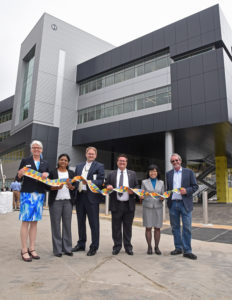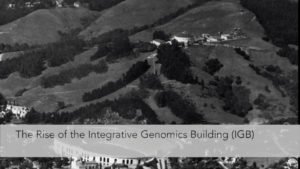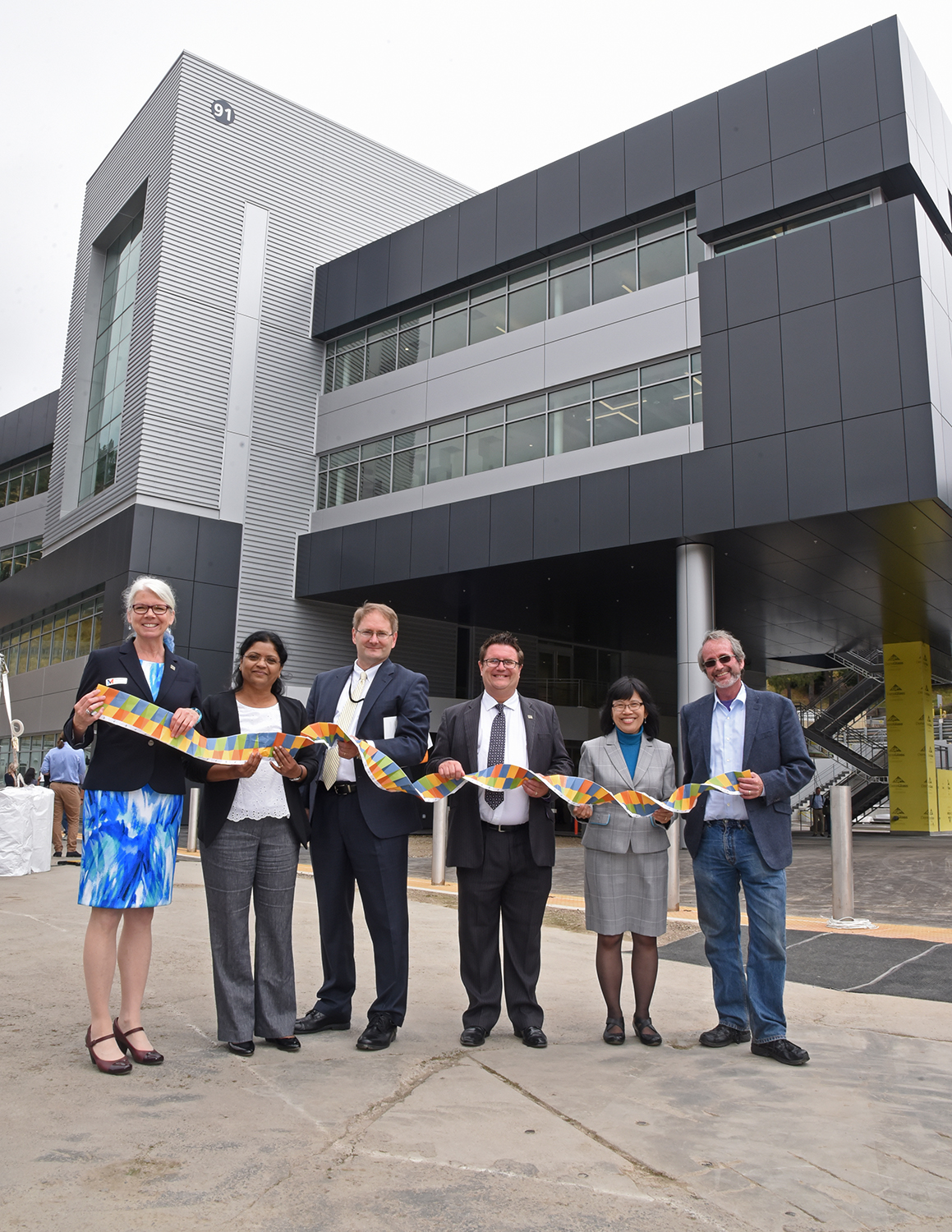Berkeley Lab dedicates the Integrative Genomics Building, and about 300 visitors get a sneak peek of the ground floor.

At the IGB Dedication (left to right): Mary Maxon, Biosciences ALD; Ramana Madupu, JGI and KBase Program Manager; Todd Anderson, Director, Biological Systems Science Division, DOE BER; Nigel Mouncey, JGI Director; Sharlene Weatherwax, Associate Director of Science for Biological and Environmental Research (BER) at the DOE Office of Science; and, Adam Arkin, KBase Lead PI; holding the DNA helix “ribbon” that was ceremonially cut during the event.
After more than two years of construction and a singular ribbon cutting, the Integrative Genomics Building (IGB) opened its doors for the first time to the staff who will soon call it home.
On June 19, Lawrence Berkeley National Laboratory (Berkeley Lab) celebrated the edifice with notable speakers articulating the vision for the building and its future inhabitants, before offering attendees a chance to tour the first floor.
“The reason for this building is a vision for integrating the Joint Genome Institute (JGI) and the Systems Biology Knowledgebase (KBase) into the main campus of the Laboratory,” said Berkeley Lab Director Michael Witherell. The two institutions, both funded by the Office of Biological and Environmental Research (BER) at the Department of Energy (DOE) Office of Science, have historically been off-site: JGI in Walnut Creek, about 18 miles away, and KBase at Aquatic Park.
Bringing JGI and KBase to the main Berkeley Lab campus, said Witherell, embeds them in an ecosystem with other world-class facilities, including the Molecular Foundry, the National Energy Research Scientific Computing Center (NERSC), and the Advanced Light Source (ALS). “By enabling collaboration across biosciences, computing, physics, and energy technologies,” said Witherell, “IGB will become a research hub that catalyzes innovation in the field of genomics.”
Combined, JGI and KBase serve nearly 3,400 users. JGI employs 250 staff members who exercise technical expertise in DNA sequencing, molecular synthesis and computational analysis to understand the complex interactions of organisms, such as how microbial communities influence soil health.
At KBase, 20 staff members create and curate “a data clearinghouse and collaborative space” that facilitates knowledge sharing among scientists, explained Sharlene Weatherwax, the Associate Director of Science for BER at the DOE Office of Science, in her remarks.
Weatherwax sees JGI and KBase as helping BER understand nature at ever larger scales. She called their partnership in the IGB a “foundation by which BER intends to continue to scale our understanding of biological systems to environmental ecosystems and, ultimately, earth system models.”
Nigel Mouncey, JGI Director, anticipates clear benefits for users of KBase and JGI resources. “Our closer collaboration in the IGB will enable us to work together to make biological data and analyses about plants, microbes and their community capabilities Findable, Accessible, Interoperable, and Reusable.”

Click the image to watch the video, “From the Footprint of the Historic Bevatron: The Rise of the Integrative Genomics Building.” The video tracks the roots of Biosciences at Berkeley Lab, and the history of the IGB’s location.
Ramana Madupu, Program Manager of JGI, KBase, and the National Microbiome Data Collaborative, explained in greater detail how JGI and KBase will be able to complement each other.
“JGI is a data producer, and KBase provides a lot of unique capabilities for data analysis,” she said. “Combining these two strengths seamlessly will be very good for users.” Madupu envisions a future where a user, for example, doesn’t have to look up data from JGI, download it, and then port it over into a standalone KBase system. Rather, a user could analyze genomes with tools jointly designed by JGI and KBase, making the user experience more effortless, she said.
“I’m sure putting some of these talented people in one room will foster more transformative ideas in data science and data analysis,” said Madupu.
JGI and KBase staff also expressed excitement at how much easier collaboration will be. “Someone I talk to on Slack, over the Internet, and once a week, get on a call with, is [in the IGB plans] now in the cubicle next to me,” said KBase senior software engineer Bill Riehl.
The gathering of JGI and KBase into the IGB is also fortuitously timed, according to JGI Director Mouncey. On July 1, Berkeley Lab will officially take on its lead role in the new National Microbiome Data Collaborative (NMDC), which was just granted funding from the DOE.
The NMDC will span multiple national labs and empower the research community to better harness microbiome data by developing an open, community-centric data science framework, said Mouncey. Further discussion about the NMDC will take place at a town hall meeting in San Francisco on Saturday, June 22, at 8:30 am at the annual conference of the American Society for Microbiology (ASM Microbe 2019).
Capping the building dedication, Associate Laboratory Director for Biosciences Mary Maxon led the event speakers in cutting a fantastical kind of ribbon: a 3D, 20-foot long, paper origami DNA strand of the nucleotides abbreviated A,T,C, and G, hand-folded by students from the East Bay. But had students built a right-handed or left-handed double helix? she asked the audience. “Rick Meyers knows,” she said, and the president of the HudsonAlpha Institute for Biotechnology, JGI’s longtime partner, did indeed, confirming the students had correctly assembled a right-handed double helix.
Leading to the culminating moment, Maxon continued: “Together, we’ll conduct a very modest genome-editing experiment to mark this very important day.” Like a cleavage enzyme, Weatherwax then snipped the helix in half (albeit, with scissors).
JGI and KBase volunteers then led groups through a portion of IGB’s ground floor: the lobby and a new wet-lab space. Others from JGI and KBase discussed ongoing research programs to visitors in a poster session in the lobby.
The IGB dedication event also offered attendees a chance to revel in the building’s design:
- The $108 million building is the first at Berkeley Lab to have all-LED lighting.
- IGB meets green building standards and is LEED Gold certification-ready.
- The building is designed to use only about 30 percent of the energy consumed annually by JGI’s Walnut Creek site.
- Electric heat pumps will help recover heat for the building, reducing the need for natural gas.
- About 10 percent of its energy budget will be solar.
- And the floorplan promotes interaction and teamwork, with huddle rooms, a break room, a large lunch room, and a 3rd floor open-air patio.




